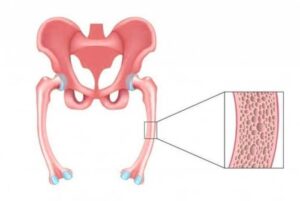 Osteomalacia refers to a marked softening of your bones, most often caused by severe vitamin D deficiency. The softened bones of children and young adults with osteomalacia can lead to bowing during growth, especially in weight-bearing bones of the legs. Osteomalacia in older adults can lead to fractures.
Osteomalacia refers to a marked softening of your bones, most often caused by severe vitamin D deficiency. The softened bones of children and young adults with osteomalacia can lead to bowing during growth, especially in weight-bearing bones of the legs. Osteomalacia in older adults can lead to fractures.
Treatment for osteomalacia involves providing enough vitamin D and calcium, both required to harden and strengthen bones, and treating disorders that might cause the condition.
Symptoms
When osteomalacia is in its early stages, you might not have symptoms, although signs of osteomalacia might show on an X-ray or other diagnostic tests. As osteomalacia progresses, you might develop bone pain and muscle weakness.
The dull, aching pain associated with osteomalacia most commonly affects the lower back, pelvis, hips, legs and ribs. The pain might be worse at night or when you put pressure on the bones. The pain is rarely relieved completely by rest.
Decreased muscle tone and leg weakness can cause a waddling gait and make walking slower and more difficult.
Causes
Osteomalacia results from a defect in the bone-maturing process. Your body uses the minerals calcium and phosphate to help build strong bones. You might develop osteomalacia if you don’t get enough of these minerals in your diet or if your body doesn’t absorb them properly. These problems can be caused by:
- Vitamin D deficiency.Sunlight produces vitamin D in your skin. Dietary vitamin D is usually from foods to which the vitamin has been added, such as cow’s milk.
People who live in areas where sunlight is limited, get little exposure to sunlight or eat a diet low in vitamin D can develop osteomalacia. Vitamin D deficiency is the most common cause of osteomalacia worldwide.
- Certain surgeries.Normally, the stomach breaks down food to release calcium and other minerals that are absorbed in the intestine. This process is disrupted if you have surgery to remove part or all of your stomach or to bypass your small intestine and can result in vitamin D and calcium deficiency.
- Celiac disease.In this autoimmune disorder, foods containing gluten, a protein found in wheat, barley and rye, can damage the lining of your small intestine. A damaged intestinal lining doesn’t absorb nutrients well, and can lead to vitamin D and calcium deficiency.
- Kidney or liver disorders.These organs are involved in activating vitamin D in your body. Problems with your kidneys or liver can affect your body’s ability to make active vitamin D.
- Some drugs used to treat seizures, including phenytoin (Dilantin, Phenytek) and phenobarbital, can cause severe vitamin D deficiency and osteomalacia.
Risk factors
The risk of developing osteomalacia is highest in people who don’t get enough dietary vitamin D and have little sun exposure, such as older adults and those who are housebound or hospitalized.
Complications
If you have osteomalacia, you’re more likely to break bones, particularly those in your ribs, spine and legs.
Treatment
Fortunately, getting enough vitamin D through oral supplements for several weeks to months can cure osteomalacia. To maintain normal blood levels of vitamin D, you’ll likely have to continue taking the supplements.
Your health care provider might also recommend that you increase your calcium or phosphorus intake, either through supplements or diet. To improve the signs and symptoms of osteomalacia, we may recommend at Alimran Medical Center any of the following treatments
Regenerative medicine treatment (Prolotherapy)
Neurons stimulation
Repetitive Transcranial Magnetic Stimulation, rTMS
Transcranial direct current stimulation (tDCS)
Steroid injection
- Trigger point injections
- Epidural steroid injections
- Electrical stimulation
- Short and long wave
- Laser therapy
- Ultrasonic therapy
- Magnatic therapy
- Exercises
